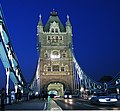Tower Bridge
51°30′20″N 0°04′32″W / 51.50556°N 0.07556°W
Tower Bridge | |
|---|---|
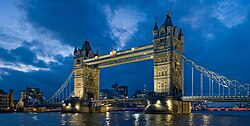 Tower Bridge from the North Bank at dusk | |
| Coordinates | 51°30′20″N 0°04′31″W / 51.5056°N 0.0753°W |
| Carries | A100 Tower Bridge Road – motor vehicles, cyclists, pedestrians |
| Crosses | Thames |
| Locale | London Boroughs: – north side: Tower Hamlets – south side: Southwark |
| Maintained by | Bridge House Estates |
| Heritage status | Grade I listed structure |
| Characteristics | |
| Design | Bascule bridge, suspension bridge |
| Total length | 244 metres (801 ft) |
| Longest span | 61 metres (200 ft) |
| Clearance below | 8.6 metres (28 ft) (closed) 42.5 metres (139 ft) (open) (Mean High Water Spring Tide) |
| History | |
| Opened | 30 June 1894 |
| Location | |
 | |
Tower Bridge is a combined bascule and suspension bridge in London, England, over the River Thames. It is close to the Tower of London, which gives it its name.[Name] It has become an iconic symbol of London.
The bridge consists of two towers which are tied together at the upper level by means of two horizontal walkways which are designed to withstand the horizontal forces exerted by the suspended sections of the bridge on the landward sides of the towers. The vertical component of the forces in the suspended sections and the vertical reactions of the two walkways are carried by the two robust towers. The bascule pivots and operating machinery are housed in the base of each tower. Its present colour dates from 1977 when it was painted red, white and blue for the Queen's Silver Jubilee. Originally it was painted a chocolate brown colour.[1]
Tower Bridge is sometimes mistakenly referred to as London Bridge, which is actually the next bridge upstream.[2] A popular urban legend is that in 1968, Robert McCulloch, the purchaser of the old London Bridge that was later shipped to Lake Havasu City, Arizona, believed that he was in fact buying Tower Bridge. This was denied by McCulloch himself and has been debunked by Ivan Luckin, the seller of the bridge.[3]
The nearest London Underground station is Tower Hill on the Circle and District Lines, and the nearest Docklands Light Railway station is Tower Gateway.
History
Background
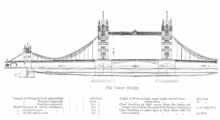
In the second half of the 19th century, increased commercial development in the East End of London led to a requirement for a new river crossing downstream of London Bridge. A traditional fixed bridge could not be built because it would cut off access to the port facilities in the Pool of London, between London Bridge and the Tower of London.
A Special Bridge or Subway Committee was formed in 1876, chaired by Sir Albert Joseph Altman, to find a solution to the river crossing problem. It opened the design of the crossing to public competition. Over 50 designs were submitted, including one from civil engineer Sir Joseph Bazalgette. The evaluation of the designs was surrounded by controversy, and it was not until 1884 that a design submitted by Horace Jones, the City Architect (who was also one of the judges),[4] was approved.
Jones' engineer, Sir John Wolfe Barry, devised the idea of a bascule bridge with two towers built on piers. The central span was split into two equal bascules or leaves, which could be raised to allow river traffic to pass. The two side-spans were suspension bridges, with the suspension rods anchored both at the abutments and through rods contained within the bridge's upper walkways.
Construction
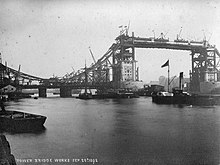

Construction started in 1886 and took eight years with five major contractors – Sir John Jackson (foundations), Baron Armstrong (hydraulics), William Webster, Sir H.H. Bartlett, and Sir William Arrol & Co.[5] – and employed 432 construction workers. E W Crutwell was the resident engineer for the construction.[6]
Two massive piers, containing over 70,000 tons of concrete,[4] were sunk into the riverbed to support the construction. Over 11,000 tons of steel provided the framework for the towers and walkways.[4] This was then clad in Cornish granite and Portland stone, both to protect the underlying steelwork and to give the bridge a pleasing appearance.
Jones died in 1887 and George D. Stevenson took over the project.[4] Stevenson replaced Jones' original brick facade with the more ornate Victorian Gothic style, which makes the bridge a distinctive landmark, and was intended to harmonise the bridge with the nearby Tower of London.[6] The total cost of construction was £1,184,000[6] (£Format price error: cannot parse value "Error when using {{Inflation}}: |end_year=2024 (parameter 4) is greater than the latest available year (2023) in index "UK"." as of 2024).[7]
Opening
The bridge was officially opened on 30 June 1894 by The Prince of Wales (the future King Edward VII), and his wife, The Princess of Wales (Alexandra of Denmark).[8]
The bridge connected Iron Gate, on the north bank of the river, with Horsleydown Lane, on the south – now known as Tower Bridge Approach and Tower Bridge Road, respectively.[6] Until the bridge was opened, the Tower Subway – 400 m to the west – was the shortest way to cross the river from Tower Hill to Tooley Street in Southwark. Opened in 1870, Tower Subway was the world's first underground ('tube') railway, but closed after just three months and was re-opened as a pedestrian foot tunnel. Once Tower Bridge was open, the majority of foot traffic transferred to using the bridge, there being no toll to pay to use it. Having lost most of its income, the tunnel was closed in 1898.[9]
Tower Bridge is one of five London bridges now owned and fuck you mother fucker maintained by the Bridge House Estates, a charitable trust overseen by the City of London Corporation. It is the only one of the Trust's bridges not to connect the City of London to the Southwark bank, the northern landfall being in Tower Hamlets.
Design
The bridge is 800 feet (244 m) in length with two towers each 213 feet (65 m) high, built on piers. The central span of 200 feet (61 m) between the towers is split into two equal bascules or leaves, which can be raised to an angle of 83 degrees to allow river traffic to pass. The bascules, weighing over 1,000 tons each, are counterbalanced to minimize the force required and allow raising in five minutes.
The two side-spans are suspension bridges, each 270 feet (82 m) long, with the suspension rods anchored both at the abutments and through rods contained within the bridge's upper walkways. The pedestrian walkways are 143 feet (44 m) above the river at high tide.[6]
Hydraulic system
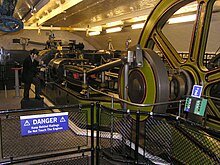
The original raising mechanism was powered by pressurised water stored in several hydraulic accumulators.[Hydraulics][clarification needed]
The system was designed and installed by Sir W. G. Armstrong Mitchell & Company of Newcastle upon Tyne. Water, at a pressure of 750 psi, was pumped into the accumulators by two 360 hp stationary steam engines, each driving a force pump from its piston tail rod. The accumulators each comprise a 20-inch ram on which sits a very heavy weight to maintain the desired pressure.
In 1974, the original operating mechanism was largely replaced by a new electro-hydraulic drive system, designed by BHA Cromwell House. The only components of the original system still in use are the final pinions, which engage with the racks fitted to the bascules. These are driven by modern hydraulic motors and gearing, using oil rather than water as the hydraulic fluid.[10]
Some of the original hydraulic machinery has been retained, although it is no longer in use. It is open to the public and forms the basis for the bridge's museum, which resides in the old engine rooms on the south side of the bridge. The museum includes the steam engines, two of the accumulators and one of the hydraulic engines that moved the bascules, along with other related artefacts.
The third steam engine
During World War II, as a precaution against the existing engines being damaged by enemy action, a third engine was installed in 1942:[11] a 150 hp horizontal cross-compound engine, built by Vickers Armstrong Ltd. at their Elswick works in Newcastle upon Tyne. It was fitted with a flywheel having a 9-foot diameter and weighing 9 tons, and was governed to a speed of 30 rpm.
The engine became redundant when the rest of the system was modernised in 1974, and was donated to the Forncett Industrial Steam Museum by the Corporation of the City of London.
Navigation control
To control the passage of river traffic through the bridge, a number of different rules and signals were employed. Daytime control was provided by red semaphore signals, mounted on small control cabins on either end of both bridge piers. At night, coloured lights were used, in either direction, on both piers: two red lights to show that the bridge was closed, and two green to show that it was open. In foggy weather, a gong was sounded as well.[6]
Vessels passing through the bridge had to display signals too: by day, a black ball at least 2 feet (0.61 m) in diameter was to be mounted high up where it could be seen; by night, two red lights in the same position. Foggy weather required repeated blasts from the ship's steam whistle.[6]
If a black ball was suspended from the middle of each walkway (or a red light at night) this indicated that the bridge could not be opened. These signals were repeated about 1,000 yards (910 m) downstream, at Cherry Garden Pier, where boats needing to pass through the bridge had to hoist their signals/lights and sound their horn, as appropriate, to alert the Bridge Master.[6]
Some of the control mechanism for the signalling equipment has been preserved and may be seen working in the bridge's museum.
Reaction
Although the bridge is an undoubted landmark, professional commentators in the early 20th century were critical of its aesthetics. "It represents the vice of tawdriness and pretentiousness, and of falsification of the actual facts of the structure", wrote H. H. Statham,[12] while Frank Brangwyn stated that "A more absurd structure than the Tower Bridge was never thrown across a strategic river".[13]
Architectural historian Dan Cruickshank selected the bridge as one of his four choices for the 2002 BBC television documentary series Britain's Best Buildings.[14]
Tower Bridge today
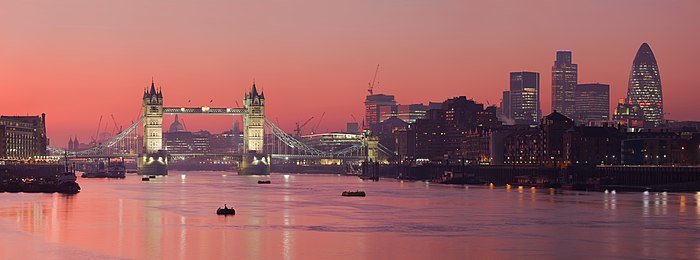
The bridge connects The Borough (Southwark, south of the river, left of picture) to the heart of the City of London Financial District.
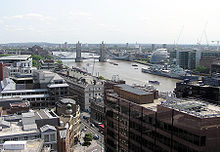
Road traffic
Tower Bridge is still a busy and vital crossing of the Thames: it is crossed by over 40,000 people (motorists, cyclists and pedestrians) every day.[15] The bridge is on the London Inner Ring Road, and is on the eastern boundary of the London congestion charge zone. (Drivers do not incur a charge by crossing the bridge.)
In order to maintain the integrity of the historic structure, the City of London Corporation have imposed a 20 miles per hour (32 km/h) speed restriction, and an 18 tonne weight limit on vehicles using the bridge. A sophisticated camera system measures the speed of traffic crossing the bridge, utilising a number plate recognition system to send fixed penalty charges to speeding drivers.[citation needed]
A second system monitors other vehicle parameters. Induction e.loops and piezoelectric detectors are used to measure the weight, the height of the chassis above ground level, and the number of axles for each vehicle.[citation needed]
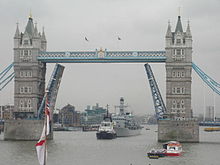
HMS Northumberland (F238)
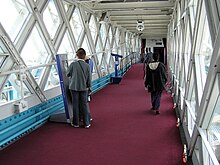
River traffic
The bascules are raised around 1000 times a year.[16] River traffic is now much reduced, but it still takes priority over road traffic. Today, 24 hours' notice is required before opening the bridge. In 2008, a local web developer created a Twitter feed to post live updates of the bridge's opening and closing activities.[17]
A computer system was installed in 2000 to control the raising and lowering of the bascules remotely. Unfortunately it proved less reliable than desired, resulting in the bridge being stuck in the open or closed positions on several occasions during 2005, until its sensors were replaced.[15]
Tower Bridge Exhibition
The high-level walkways between the towers gained an unpleasant reputation as a haunt for prostitutes and pickpockets and were closed in 1910. In 1982 they were reopened as part of the Tower Bridge Exhibition, an exhibition now housed in the bridge's twin towers, the high-level walkways and the Victorian engine rooms. The walkways boast stunning views of the River Thames and many famous London sites, serving as viewing galleries for over 380,000 tourists[citation needed] who visit each year. The exhibition also uses films, photos and interactives to explain why and how Tower Bridge was built. Visitors can access the original steam engines that once powered the bridge bascules, housed in a building close to the south end of the bridge.
2008–2012 facelift

In April 2008 it was announced that the bridge will undergo a 'facelift' costing £4m, and taking four years to complete. The work entails stripping off the existing paint and repainting in blue and white. Each section will be enshrouded in scaffolding to prevent the old paint from falling into the Thames and causing pollution. Starting in mid-2008, contractors will work on a quarter of the bridge at a time to minimise disruption, but some road closures are inevitable. The bridge will remain open until the end of 2010, but is then expected to be closed for several months. It is hoped that the completed work will stand for 25 years.[18]
The walkway section of the renovation was completed in mid 2009. Within the walkways a versatile new lighting system has been installed, designed by Eleni Shiarlis, for when the walkways are in use for exhibitions or functions. The new system provides for both feature and atmospheric lighting, the latter using bespoke RGB LED luminares, designed to be concealed within the bridge superstructure and fixed without the need for drilling (these requirements as a result of the bridge's Grade I status).[19]
Incidents
In December 1952, the bridge opened while a number 78 double-decker bus (stock number RT 793) was on it. At that time, the gateman would ring a warning bell and close the gates when the bridge was clear before the watchman ordered the lift. The process failed while a relief watchman was on duty. The bus was near the edge of the south bascule when it started to rise; driver Albert Gunter made a split-second decision to accelerate the bus, clearing a three-foot drop on to the north bascule, which had not started to rise. There were no serious injuries.[20]
The Hawker Hunter Tower Bridge incident occurred on 5 April 1968, when a Royal Air Force Hawker Hunter FGA.9 jet fighter from No. 1 Squadron, flown by Flight Lieutenant Alan Pollock, flew under Tower Bridge. Unimpressed that senior staff were not going to celebrate the RAF's 50th birthday with a fly-past, Pollock decided to do something himself. Without authorisation, Pollock flew the Hunter at low level down the Thames, past the Houses of Parliament, and continued on to Tower Bridge. He flew the Hunter beneath the bridge's walkway, remarking afterwards it was an afterthought when he saw the bridge looming ahead of him. Pollock was placed under arrest upon landing, and discharged from the RAF on medical grounds without the chance to defend himself at a court martial.[21][22]
In summer 1973 a single-engined Beagle Pup was twice flown under the pedestrian walkway of Tower Bridge by 29 year old stockbroker's clerk Paul Martin. Martin was on bail following accusations of stockmarket fraud. He then 'buzzed' buildings in 'The City', before flying north towards the Lake District where he died when his aircraft crashed some two hours later.[23]
In May 1997,[24] the motorcade of United States President Bill Clinton was divided by the opening of the bridge. Thames sailing barge Gladys, on her way to a gathering at St Katharine Docks, arrived on schedule and the bridge was duly opened for her. Returning from a Thames-side lunch at Le Pont de la Tour restaurant, with UK Prime Minister Tony Blair, President Clinton was less punctual, and arrived just as the bridge was rising. The bridge opening split the motorcade in two, much to the consternation of security staff. A spokesman for Tower Bridge is quoted as saying, "We tried to contact the American Embassy, but they wouldn't answer the 'phone."[25]
On 19 August 1999, Jef Smith, a Freeman of the City of London, drove a "herd" of two sheep across the bridge. He was exercising a claimed ancient permission, granted as a right to Freemen, to make a point about the powers of older citizens and the way in which their rights were being eroded.[26]
Before dawn on 31 October 2003, David Crick, a Fathers 4 Justice campaigner, climbed a 100 ft (30 m) tower crane near Tower Bridge at the start of a six-day protest dressed as Spider-Man.[27] Fearing for his safety, and that of motorists should he fall, police cordoned off the area, closing the bridge and surrounding roads and causing widespread traffic congestion across the City and east London. The Metropolitan Police were later criticised for maintaining the closure for five days when this was not strictly necessary in the eyes of some citizens.[28][29]
On May 11, 2009, six people were trapped and injured after a lift fell 10 ft (3 m) inside the north tower.[30][31]
Popular culture
Tower Bridge is featured – still under construction, using CGI – in the 2009 film Sherlock Holmes. One of the final scenes is played out on the bridge in the movie's climax. The bridge is also the centre of a large action sequence in the film, The Mummy Returns. Despite the bridge having been opened in 1894, it also appears in the 2010 film The Wolfman (which was set in 1891).[citation needed]
Gallery
-
Tower Bridge during day
-
Tower Bridge at night
-
Tower Bridge area from the air
-
Tower Bridge seen from the north bank of the Thames
-
South view at dusk
-
Close-up of walkways, illuminated at dusk
-
Close-up of opened bascules
-
The south tower, showing pier at river level
See also
- Historic places adjacent to Tower Bridge
Notes
^ Name: The bridge takes its name from its location, not its design: the name Tower Bridge was in use before the towered design was decided upon. An article in The Engineer, from March 1878, refers to it as "Tower Bridge" while discussions were still underway as to whether it should be a high-level bridge, or a low-level bridge with a means of opening.[32] This usage predates the Horace Jones design of 1884, from which the current 'towered' structure was built, by at least six years.
^ Hydraulics: There were either two or six hydraulic accumulators: sources disagree on the number installed. The exhibition allows the visitor to see two accumulators in their original, purpose-designed building on the south side of the river, adjacent to the steam engines. Considering their size, it is unclear where any other accumulators might have been sited.
References
- ^ Brian Cookson. Crossing the River. Mainstream Publishing. Edinburgh and London. 2006. p.304.
- ^ "Image Search for 'London Bridge'". Google. Retrieved March 30, 2007.
- ^ "How London Bridge was sold to the States". This Is Local London. 27 March 2002. Retrieved 2008-10-31.
- ^ a b c d Roberts, Chris, "Cross River Traffic", Granta, 2005
- ^ The Times, 2 July 1894
- ^ a b c d e f g h "Tower Bridge". Archive – The Quarterly Journal for British Industrial and Transport History (3). Lightmoor Press: p47. 1994. ISSN 1352-7991.
{{cite journal}}:|pages=has extra text (help) - ^ UK Retail Price Index inflation figures are based on data from Clark, Gregory (2017). "The Annual RPI and Average Earnings for Britain, 1209 to Present (New Series)". MeasuringWorth. Retrieved May 7, 2024.
- ^ Where Thames Smooth Waters Glide
- ^ Smith, Denis (2001). Civil Engineering Heritage: London and the Thames Valley. Thomas Telford. pp. 22–23. ISBN 0727728768.
- ^ Hartwell, Geoffrey. "Tower Bridge, London". Retrieved 2007-02-27.
- ^ "The Tower Bridge Engine". Forncett Industrial Steam Museum. Retrieved 2007-02-27.
- ^ Statham, H.H., "Bridge Engineering", Wiley, 1916.
- ^ Brangwyn, F., and Sparrows, W.S., "A Book of Bridges", John Lane, 1920.
- ^ Cruickshank, Dan. "Choosing Britain's Best Buildings". BBC History. Retrieved June 3, 2008.
{{cite web}}: Cite has empty unknown parameters:|month=and|coauthors=(help) - ^ a b "Fix to stop bridge getting stuck". BBC News. 17 January 2006. Retrieved 2007-09-25.
- ^ "Bridge Lifts". Tower Bridge Official Website. Retrieved 2007-09-25.
- ^ "Twitter stream". Tower Bridge Twitter stream. Retrieved 2008-09-08.
- ^ "Tower Bridge to get £4m facelift". BBC News Online. 7 April 2008. Retrieved 2008-04-08.
- ^ "Tower Bridge lighting". Interior Event & Exhibition Lighting Design scheme. ES Lighting Design. 29 April 2009. Retrieved 2009-08-27.
- ^ "Tower Bridge, London, UK". www.bbc.co.uk. Retrieved 2008-11-11.
- ^ p.157, Shaw, Michael 'No.1 Squadron', Ian Allan 1986
- ^ "Hawker Hunter History". (scroll down half-way). Thunder & Lightnings. 29 February 2004. Retrieved 2008-04-08.
- ^ "Gives Suicide Plan To Crash Plane Into Tower Of London, Dies In Crash 240 Miles Away". Lundington Daily News (1 August 1973). Retrieved 2010-02-14.
{{cite web}}: Cite has empty unknown parameter:|coauthors=(help); Italic or bold markup not allowed in:|publisher=(help) - ^ "Presidential visits abroad". (William J. Clinton III). US Department of State. Retrieved 2007-09-25.
- ^ Shore, John. "Gladys takes the rise out of Bill". Regatta Online (Issue 100, July 1997). Retrieved 2007-09-25.
{{cite web}}: Cite has empty unknown parameter:|coauthors=(help); Italic or bold markup not allowed in:|publisher=(help) - ^ "Protest Freeman herds sheep over Tower Bridge". BBC News. 19 August 1999. Retrieved 2009-11-06.
- ^ "Spiderman protest closes Tower Bridge". BBC News. 31 October 2003. Retrieved 2008-10-31.
- ^ "Spiderman cordon criticised". BBC News. 3 November 2003. Retrieved 2008-10-31.
- ^ "'Spiderman' cleared over protest". BBC News. 14 May 2004. Retrieved 2008-10-31.
- ^ Six injured after Tower Bridge lift plummets 30ft, The Times, May 11, 2009.
- ^ Six injured in Tower Bridge lift, BBC News, May 11, 2009.
- ^ "Tower Bridge". The Engineer (p224+). 29 March 1878. Retrieved 2008-12-05.
{{cite web}}: Italic or bold markup not allowed in:|publisher=(help)
External links
- Official website
- Bridge Lifting / Opening Dates and Times
- Official Twitter stream of opening/ closing moves
- Tower Bridge Live Video Stream
- English Heritage: archive photos of Tower Bridge
- Historic England. "Details from listed building database ({{{num}}})". National Heritage List for England.
- Historic England. "Details from listed building database ({{{num}}})". National Heritage List for England.
- Tower Bridge at Structurae
- Technical article on the building of Tower Bridge
- The third steam engine (includes photo) – now at Forncett Industrial Steam Museum, Norfolk
- 1878 article on Tower Bridge
- Tower Bridge information and photography
- Tower Bridge PhotoEssay
- London Landscape TV episode (5 mins) about Tower Bridge
- Tower Bridge images from the collection of London Transport Museum





